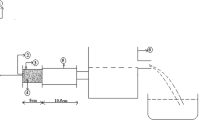Abstract
The hydraulic heterogeneity of Cambrian clays is examined in the context of the problem of final isolation of wastes at Krasnyi Bor burial ground. The properties of clays were studied in a laboratory using undisturbed samples taken from pit walls and borehole core samples. In addition, the permeability heterogeneity of clays was studied in situ by packer interval pum** with the use of Lugeon method. Visual studies of outcrops in LSR quarry has shown that the clay massif has a block structure. The blocks are separated by a system of orthogonal subhorizontal and subvertical fractures. The size of blocks increases with depth from a few centimeters to several tens of meters at a depth of 20 m. However, no open fractures have been found during geotechnical studies of core samples taken from numerous wells. Laboratory studies showed that the average hydraulic conductivity of Cambrian clay along the bedding is 8.8 × 10–7 m/day, and that аcross the bedding is 9.0 × 10–8 m/day. The value of conductivity anisotropy is stable for all samples and averages 9.5. Selective pum** tests in the well showed that, under natural conditions, the block system is consolidated, i.e., the clay massif works as an impermeable aquiclude. Injection into isolated intervals with a gage pressure above 4 times the lithostatic value causes opening of the fracture system. The hydraulic conductivity of the rock with open fractures can reach 0.5 m/day. However, at a decrease in the gage pressure, the fractures close and the clay massif again becomes a flow barrier. Thus, depending on the external conditions, Cambrian clays can serve as either an impermeable barrier or a permeable medium.








Similar content being viewed by others
REFERENCES
Briling, I.A., Fil’tratsiya v glinistykh porodakh (Groundwater Flow in Clayey Rocks), Moscow: Izd. VIEMS, 1984.
Gol’dberg,V.M. and Skvortsov., N.P., Pronitsaemost’ i fil’tratsiya v glinakh (Clay Permeability and Groundwater Flow in It), Moscow: Nedra, 1986.
GOST (State Standard) 25 584-2016: Soils. Methods for Laboratory Determination of Hydraulic Conductivity. https://docs.cntd.ru/document/1200141112
GOST (State Standard) 12 248.3-2020: Determining Strength and Deformation Characteristics by the Method of Triaxial Compression. https://docs.cntd.ru/document/566409062
Dashko, R.E. and Eremeeva, A.A., Analysis and estimation of an increase in the safety of burying low-activity wastes in the Lower Cambrian Blue Clays in the western Leningrad oblast, Zap. Gorn. Inst., vol. 154, 2004, pp. 131–135.
Dashko, R.E. and Korobko, A.A., Geotechnical aspects of studying Lower Cambrian clays in St. Petersburg as construction basements, Zhil. Stroit., 2014, no. 9, pp. 19–22.
Eremeeva, A.A., Engineering-geological and geoecological assessment of the burial conditions of industrial waste in Lower Cambrian clays in Leningrad oblast, Cand. Sci. (Geol.-Mineral.), Dissertation, St.Petersburg, 2002, p. 212.
Korobko, A.A., Geoengineering analysis and assessment of construction and operation conditions for structures of different purpose in Predglintovaya Lowland (St. Petersburg region), Extended Abstract of Cand Sci. (Geol.-Mineral.) Dissertation, St. Petersburg, 2015.
Lomtadze, V.D., Mechanical-and-physical properties of the Lower Cambrian clays in the northwestern margin of the Russian Platform, Zap. Gorn. Inst., 1958, vol. 34, pp. 154–188.
Rumynin, V.G., Experience of studying clayey strata and crystalline massifs as geological media for the final insulation of radioactive wastes, Radioakt. Otkh., 2017, no. 1, pp. 43–54.
Rumynin, V.G. and Nikulenkov, A.M., Zonality of the physical properties of kotlinskie clays, Vendian system (northwestern Russian Platform), Zap. Gorn. Inst., 2012, vol. 197, pp. 191–196.
Rumynin, V.G., Pankina, E.B., Yakushev, M.F., et al., Otsenka vliyaniya atomno-promyshlennogo kompleksa na podzemnye vody i smezhnye prirodnye ob’ekty (Assessing the Effect of Nuclear-Industrial Complex on Groundwater and Associated Natural Objects), SPb.: Izd. SPbGU, 2002.
Tertsagi, K. and Pek R. Mekhanika gruntov v inzhenernoi praktike (Soil and Rock Mechanics in Engineering Practice), Moscow: Gos. Izd. Liter. Stroit., Arkhit. Stroit. Mater., 1958.
Chasovnikova, E.V., Studying changes in the composition and properties of Cambrian clays in their interaction with liquid industrial chemical wastes at the Krasnyi Bor burial ground with the aim to forecast environmental protection, Leningrad: NII Zemnoi Kory LGU, LGU, 1981.
Arnould, M., Discontinuity networks in mudstones: a geological approach. Implications for radioactive wastes isolation in deep geological formation in Belgium, Bull. Eng. Geol. Environ., 2006, vol. 65, pp. 413–422.
Blumling, P., Bernier, F., Lebon, P., and Derek Martin, C., The excavation damaged zone in clay formations time-dependent behavior and influence on performance assessment, Physics and Chemistry of the Earth, Parts A/B/C, 2007, vol. 32, nos. 8–14, pp. 588–599. https://doi.org/10.1016/j.pce.2006.04.034
Bock, H., Blumling, P., and Konietzky, H., Study of the micro-mechanical behaviour of the Opalinus Clay: an example of co-operation across the ground engineering disciplines, Bull. Eng. Geol. Environ., 2006, vol. 65, pp. 195–207.
Houlsby, A.C., Routine interpretation of the Lugeon water-test, Q. J. Eng. Geol., 1976, vol. 9, no. 4, pp. 303–313. https://doi.org/10.1144/GSL.QJEG.1976.009.04.03
Huysmans, M. and Dassargues, A., Stochastic analysis of the effect of spatial variability of diffusion parameters on radionuclide transport in a low permeability clay layer, Hydrogeol. J., 2006, vol. 14, pp. 1094–1106.
Lugeon, M., Barrages et geologie, Bulletin Technique de La Suisse Romande, 1932, vol. 58, nos. 19–20, pp. 225–240.
Moye, D.G., Diamond drilling for foundation exploration, Civil Engineering Transactions. Institution of Engineers of Australia, 1967, vol. Ce 9, no. 1, pp. 95–100.
Author information
Authors and Affiliations
Corresponding author
Additional information
Translated by G. Krichevets
Rights and permissions
About this article
Cite this article
Vilkina, M.V., Nikulenkov, A.M. & Rumynin, V.G. Studying the Hydraulic Heterogeneity of Cambrian Clays at the Substantiation of Final Isolation of Toxic Wastes. Water Resour 49 (Suppl 2), S47–S58 (2022). https://doi.org/10.1134/S0097807822080127
Received:
Revised:
Accepted:
Published:
Issue Date:
DOI: https://doi.org/10.1134/S0097807822080127




